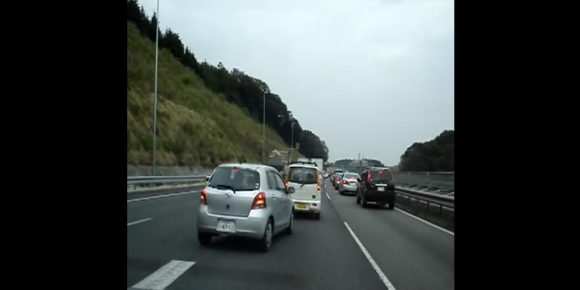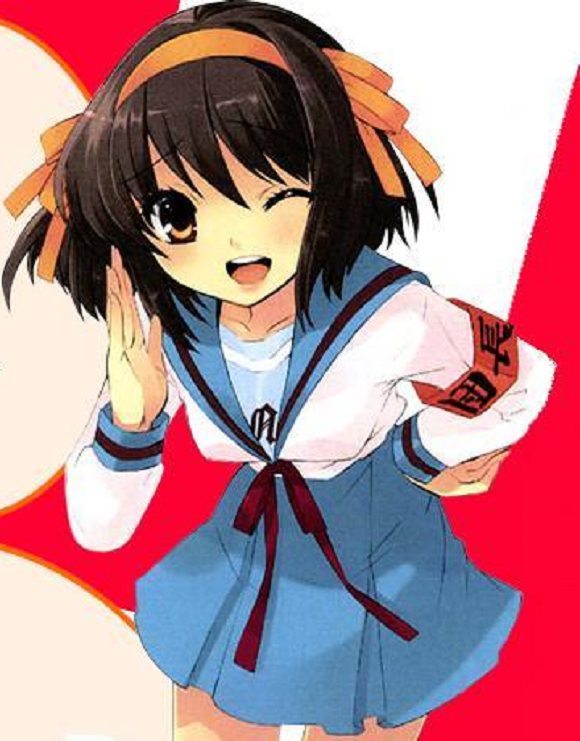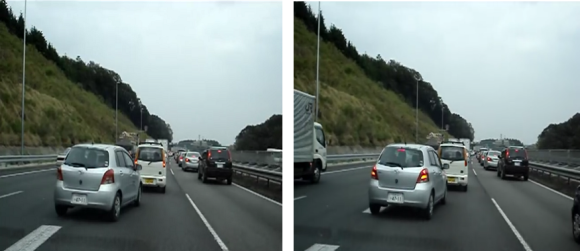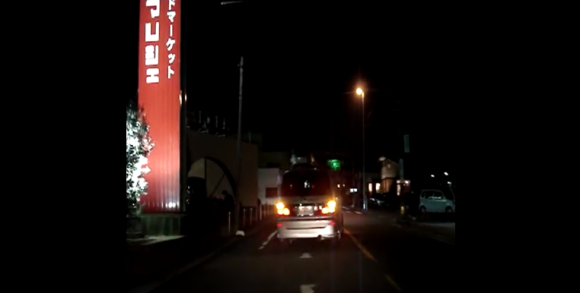
Japanese culture places a lot of importance on taking care of yourself and not inconveniencing others. Sooner or later we all end up needing a little help, though, which is why the Japanese language has a half-dozen regularly used phrases that all mean “thank you.”
But while having that arsenal of expressions with which to show your gratitude comes in handy, it won’t do you much good if you want to thank someone who’s not in earshot, such as a fellow motorist who let you into their lane on the expressway. That’s why Japanese drivers follow a bit of automotive protocol that lets them deliver a message of thanks with the push of a button.
Japan does have nonverbal ways of saying thank you, of course. The most common is to hold up a hand, fingertips pointing up and pinkie-edge facing forward. Technically, this means “I’m sorry,” but Japanese often doesn’t really differentiate between saying “Thank you for helping me” and “I’m sorry for making you help me.”
▼ No problem, Haruhi!
But while this would be an acceptable way of saying thank you on the road, it requires a clear line of sight between you and the other drivers, plus enough light for them to see into your car. If you don’t have either, though, there’s another way to get your message across, as shown by The Japan Channel Dcom on its YouTube channel.
As the calm-voiced narrator explains, if someone shows you courtesy on the road, it’s customary to give a few blinks of your hazard lights to let them know you noticed and appreciated their kindness.
It’s an extremely clever solution, plus it seems a lot more appropriate than beeping your horn, which can come off sounding aggressive and, regardless of how it’s interpreted, sends the sound more towards the car in front of you than the one behind that just did you a favor.
Called “thank you hazard” by Japanese drivers, its use isn’t restricted to lane changes on congested expressways. It’s also polite to hit your hazards for a second or two after someone lets you turn in on one of Japan’s many uncontrolled intersections.
In recent years, Japanese automakers have made some incredible strides in humanoid robotics. Until they develop the technology that lets our cars bow to each other, though, the thank you hazards remain one of the best ways to make everyone’s drive a little less stressful and more polite.
Source: Kotaro, The Japan Channel Dcom
Top image: YouTube
Insert images: Seesaa, YouTube




 Hate tailgaters? Japanese driver devises a clever, creepy way to keep them off your bumper
Hate tailgaters? Japanese driver devises a clever, creepy way to keep them off your bumper Super-hospitable Kyoto driver screens Studio Ghibli anime on back of his car for others to watch
Super-hospitable Kyoto driver screens Studio Ghibli anime on back of his car for others to watch Truck driver hailed as “hero” for cutting off car on wet highway
Truck driver hailed as “hero” for cutting off car on wet highway Samurai road rage as man attacks motorist with replica samurai sword on Japanese expressway
Samurai road rage as man attacks motorist with replica samurai sword on Japanese expressway Japanese beef bowl chain Sukiya’s 2026 Smile Box lucky bag basically pays for itself
Japanese beef bowl chain Sukiya’s 2026 Smile Box lucky bag basically pays for itself Rakuten randomly offers 58 New Year’s osechi feasts in Japan, but did we get a star or a dud?
Rakuten randomly offers 58 New Year’s osechi feasts in Japan, but did we get a star or a dud? Majority of Japanese mayors say foreign residents are essential but most see good and bad effects
Majority of Japanese mayors say foreign residents are essential but most see good and bad effects Japan’s new difficult-to-drink-from beer glass protects your liver, but it’s a brutal experience
Japan’s new difficult-to-drink-from beer glass protects your liver, but it’s a brutal experience New train recreates hotel atmosphere with wood interiors and views from the foot of Mount Fuji
New train recreates hotel atmosphere with wood interiors and views from the foot of Mount Fuji 100 years of Japanese women’s hair and makeup trends in less than a minute and a half【Video】
100 years of Japanese women’s hair and makeup trends in less than a minute and a half【Video】 Original Totoro plush toys from 80s and 90s re-issued for Studio Ghibli exhibition
Original Totoro plush toys from 80s and 90s re-issued for Studio Ghibli exhibition The dark kawaii fashions of the Ank Rouge lucky bag are here!【Photos】
The dark kawaii fashions of the Ank Rouge lucky bag are here!【Photos】 4chan creator hands reins over to 2channel’s Hiroyuki Nishimura
4chan creator hands reins over to 2channel’s Hiroyuki Nishimura Disney villain-themed eyeglasses in four styles up for presale in Japan
Disney villain-themed eyeglasses in four styles up for presale in Japan Starbucks Japan ready to get Year of the Horse started with adorable drinkware and plushies【Pics】
Starbucks Japan ready to get Year of the Horse started with adorable drinkware and plushies【Pics】 Hayao Miyazaki says Happy New Year to Studio Ghibli fans with new art for Year of the Horse
Hayao Miyazaki says Happy New Year to Studio Ghibli fans with new art for Year of the Horse We found possibly the quietest Japanese-style hotel in Tokyo’s bustling Shinjuku district
We found possibly the quietest Japanese-style hotel in Tokyo’s bustling Shinjuku district Cup Noodle tries an authentic Jiro-style ramen, but something’s not quite right
Cup Noodle tries an authentic Jiro-style ramen, but something’s not quite right The best Starbucks Japan Frappuccinos we want to drink again in 2026
The best Starbucks Japan Frappuccinos we want to drink again in 2026 We revisited Sweets Paradise after a decade to see if Japan’s dessert buffet still delivers
We revisited Sweets Paradise after a decade to see if Japan’s dessert buffet still delivers That time Seiji called JASRAC to ask why he didn’t get paid royalties for his song being on TV
That time Seiji called JASRAC to ask why he didn’t get paid royalties for his song being on TV Japan’s oldest largetooth sawfish in captivity back on display in Mie Prefecture
Japan’s oldest largetooth sawfish in captivity back on display in Mie Prefecture Pizza Hut Japan’s hot lucky bags are perfect for a New Year’s pizza party
Pizza Hut Japan’s hot lucky bags are perfect for a New Year’s pizza party 7-Eleven Japan starts new temporary luggage storage service in over 300 branches
7-Eleven Japan starts new temporary luggage storage service in over 300 branches Disillusionment at Tsukiji’s tourist-target prices led us to a great ramen restaurant in Tokyo
Disillusionment at Tsukiji’s tourist-target prices led us to a great ramen restaurant in Tokyo Starbucks teams up with 166-year-old Kyoto doll maker for Year of the Horse decorations【Photos】
Starbucks teams up with 166-year-old Kyoto doll maker for Year of the Horse decorations【Photos】 Tokyo considering law requiring more trash cans following litter increase in heavily touristed area
Tokyo considering law requiring more trash cans following litter increase in heavily touristed area Tokyo’s Tsukiji sushi neighborhood asks tour groups to stay away for the rest of the month
Tokyo’s Tsukiji sushi neighborhood asks tour groups to stay away for the rest of the month Tokyo event lets you travel back in time, for free, to celebrate 100 years since Showa era start
Tokyo event lets you travel back in time, for free, to celebrate 100 years since Showa era start Japan may add Japanese language proficiency, lifestyle classes to permanent foreign resident requirements
Japan may add Japanese language proficiency, lifestyle classes to permanent foreign resident requirements Sanrio theme park in Japan announces plans to expand into a Sanrio resort
Sanrio theme park in Japan announces plans to expand into a Sanrio resort Stamina-destroying “Paralysis Noodles” are Tokyo’s newest over-the-top ramen innovation
Stamina-destroying “Paralysis Noodles” are Tokyo’s newest over-the-top ramen innovation Survey asks foreign tourists what bothered them in Japan, more than half gave same answer
Survey asks foreign tourists what bothered them in Japan, more than half gave same answer Japan’s human washing machines will go on sale to general public, demos to be held in Tokyo
Japan’s human washing machines will go on sale to general public, demos to be held in Tokyo Japan’s deadliest food claims more victims, but why do people keep eating it for New Year’s?
Japan’s deadliest food claims more victims, but why do people keep eating it for New Year’s? We deeply regret going into this tunnel on our walk in the mountains of Japan
We deeply regret going into this tunnel on our walk in the mountains of Japan Studio Ghibli releases Kodama forest spirits from Princess Mononoke to light up your home
Studio Ghibli releases Kodama forest spirits from Princess Mononoke to light up your home Major Japanese hotel chain says reservations via overseas booking sites may not be valid
Major Japanese hotel chain says reservations via overseas booking sites may not be valid Put sesame oil in your coffee? Japanese maker says it’s the best way to start your day【Taste test】
Put sesame oil in your coffee? Japanese maker says it’s the best way to start your day【Taste test】 No more using real katana for tourism activities, Japan’s National Police Agency says
No more using real katana for tourism activities, Japan’s National Police Agency says Starbucks Japan reveals new sakura drinkware collection, inspired by evening cherry blossoms
Starbucks Japan reveals new sakura drinkware collection, inspired by evening cherry blossoms Updated cherry blossom forecast shows extra-long sakura season for Japan this year
Updated cherry blossom forecast shows extra-long sakura season for Japan this year 24,000 Japanese drivers scrupulously submit payment offers after expressway collection system breaks
24,000 Japanese drivers scrupulously submit payment offers after expressway collection system breaks Japan’s Prime Minister has team of gloved officials that operates as his personal turn signal【Vid】
Japan’s Prime Minister has team of gloved officials that operates as his personal turn signal【Vid】 Getting a driver’s license in Japan the hard way: The End
Getting a driver’s license in Japan the hard way: The End Only 30 percent of Japanese drivers stop for pedestrians at crosswalks, survey says
Only 30 percent of Japanese drivers stop for pedestrians at crosswalks, survey says Getting a driver’s license in Japan the hard way: The first driving test a few more times
Getting a driver’s license in Japan the hard way: The first driving test a few more times Getting a driver’s license in Japan the hard way: The first driving test
Getting a driver’s license in Japan the hard way: The first driving test Japanese custom of bowing to cars at crosswalks keeps locals safe, warms Internet’s hearts【Video】
Japanese custom of bowing to cars at crosswalks keeps locals safe, warms Internet’s hearts【Video】 Should saying thanks at a Japanese convenience store go without saying?
Should saying thanks at a Japanese convenience store go without saying? Heartstopping video shows narrowly averted car crash, absurdly slow driver【Video】
Heartstopping video shows narrowly averted car crash, absurdly slow driver【Video】 Japanese cat gets in on trick-or-treating fun without saying a word thanks to clever idea【Video】
Japanese cat gets in on trick-or-treating fun without saying a word thanks to clever idea【Video】 Nissan’s New Safety Technology Wrestles Control of the Wheel from Drivers Facing Doom
Nissan’s New Safety Technology Wrestles Control of the Wheel from Drivers Facing Doom Want to see right through your car? Amazing video projection system lets drivers do just that
Want to see right through your car? Amazing video projection system lets drivers do just that
Leave a Reply